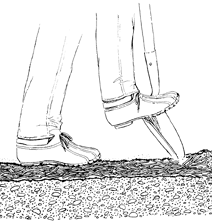How to prepare the soil for planting
Plants grow best in soil that has been loosened before planting to allow ready penetration of the two things roots need most: oxygen and water. A shovel or spade is the tool of choice for breaking ground, turning the soil, and chopping up clods; a rototiller comes in handy for preparing a large area. Gardening books often recommend the arduous practice of double digging flower borders, turning soil to a depth twice the length of a shovel blade. We get good results digging down just one shovel's depth. Unless your soil requires extensive rehabilitation, you probably will, too.

Unless you are planting a woody plant on its own (in a lawn, for example), turn a healthy layer of organic matter—such as compost, aged manure, leafmold, or peat moss—into your soil. Spread 3-4 inches of organic matter over the area to be prepared. Turn organic matter into soil to a depth of a shovel blade—approximately 10-12 inches.
Organic matter improves the drainage of heavy clay soils and helps light sandy soils hold moisture longer. It's the secret of success behind all the good gardens we know.
How to test your soil?We recommend that you visit your local Cooperative Extension Service to find out about soil testing in your area. Follow this link for a directory of institutions involved in the Cooperative Extenstion program.


